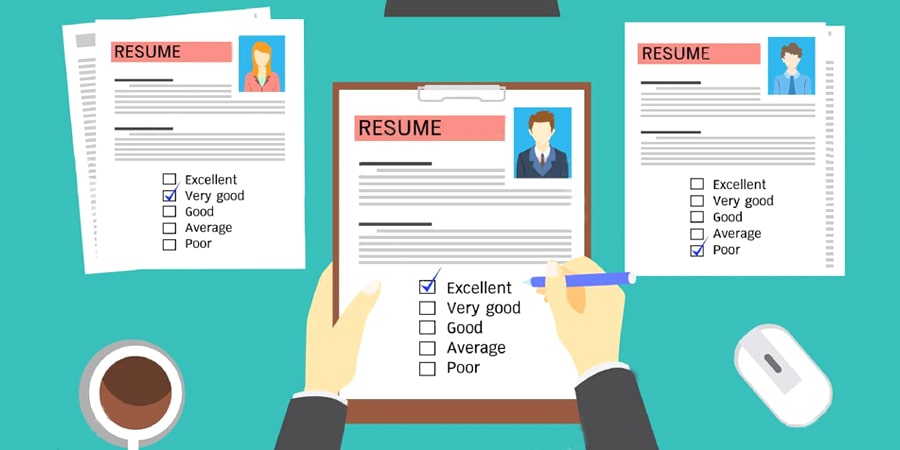
Guide on Writing a Resume – Creating the Perfect Ticket to Your Dream Job
After getting your diploma from college and taking a suitable amount of time off, now’s the perfect time for the next move: create a resume, a ticket to a job you’ve always wanted. Your resume can either make or break the first step into the corporate world, and you’re determined to create a proper summary of your abilities. However, one question comes into your mind: “What should I do?”
Before we jump right into things, check your current resume and get ready to take some notes. We will help you construct the ideal resume and convince the hiring manager that you are fit for the role.
Please take note that while we present you the appropriate practice for writing resumes, there isn’t a guarantee that your piece will help you get 100% employed. The interview process is also a hiring factor and demands a different kind of preparation.
Differences Between Resume and Curriculum Vitae
Back in college, subjects such as Personality Development and Corporate Communications will teach you about the inner workings of the corporate world. From these subjects, professors also discuss the features of a resume and a curriculum vitae — documents that detail your skills for recruiters to identify your suitability for a position.
A resume is a document that contains your work experience, educational background, and achievements. Resumes are usually extensive and two pages long, with different formats available for selection. Some applicants submit a single-page resume containing only the relevant information required by the employer.
Curriculum Vitae (abbreviated as “CV”), on the other hand, is a detailed document with contents similar to a resume but different in terms of formatting. It seeks to emphasize details such as achievements, awards and scholarship grants together with the applicant’s career in a brief manner.
After writing your first resume or CV, you will notice the difference between its formats and presentation. In the United States, resumes are competency-based while CVs are credential-based. Jobs in the academe research, and medical fields require CVs to identify the applicant’s educational background, certifications and awards, professional experience, and affiliations with licensed and renowned organizations.
Companies in the Philippines might request for either a resume or a CV depending on the requirements specified on their job post. However, how are you supposed to construct one? Not to worry, the next section will further discuss what goes on your job application and how you can improve them.
Writing your Resume
Creating a job application may take some time. You might be thinking of the details a resume must have and how pristine it should look. The process may be tedious, but once you master the essentials in the writing process, you’re off to great opportunities in no time.
Take note that your resume must have the following details or sections:
- Personal Information
- Your Objective or Professional Summary
- Educational Background
- Work Background
- Skills and Competencies
- Awards and Affiliations
- Achievements
You may opt to modify portions of your resume to your liking as long as it doesn’t look messy. Remember that an unorganized resume can leave you with a bad impression so keep your content tidy for a presentable resume.
1. List Down Relevant Information
The initial parts of the resume must contain your personal information, educational background, and previous work experience. Fresh graduates applying for the first time must include their internship experience as a substitute for a detailed work background. After gathering the necessary data, compile them on a piece of paper or encode them on your computer.
We urge you to put relevant information on your resume and refrain from adding unnecessary details. Leave out other personal data (age, sex, height), salary history, and skills not connected to the job function of your chosen field.
2. Select a Format
There are three types of resumes: chronological, functional, and combined. Each format may vary in terms of sequence and formatting. Remember to check your details first before you pick a format to use. However, if you choose to create a CV, your only concern will be its length and the number of details you place.
Our sample resumes includes instructions on what you can do to create an orderly resume. To lessen the hassle of building a resume from scratch, you can check the sample formats below to get a headstart and construct your ideal resume.
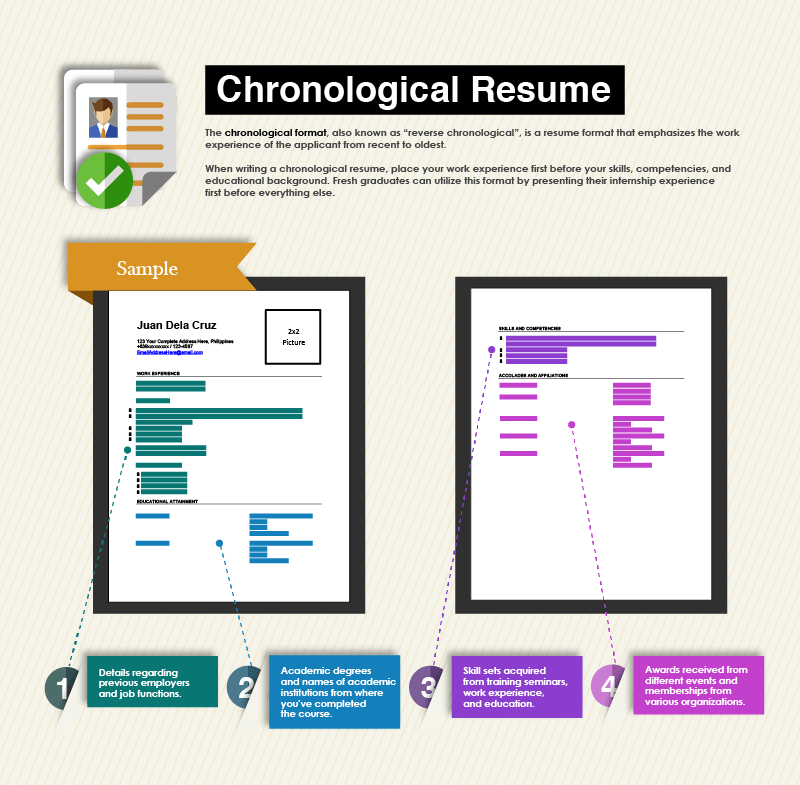


The chronological format, also known as “reverse chronological”, is a resume format that emphasizes the work experience of the applicant from recent to oldest. According to Novoresume, this is the most common format that employers receive from applicants.
When writing a chronological resume, place your work experience first before your skills, competencies, and educational background. Fresh graduates can utilize this format by presenting their internship experience first before everything else.
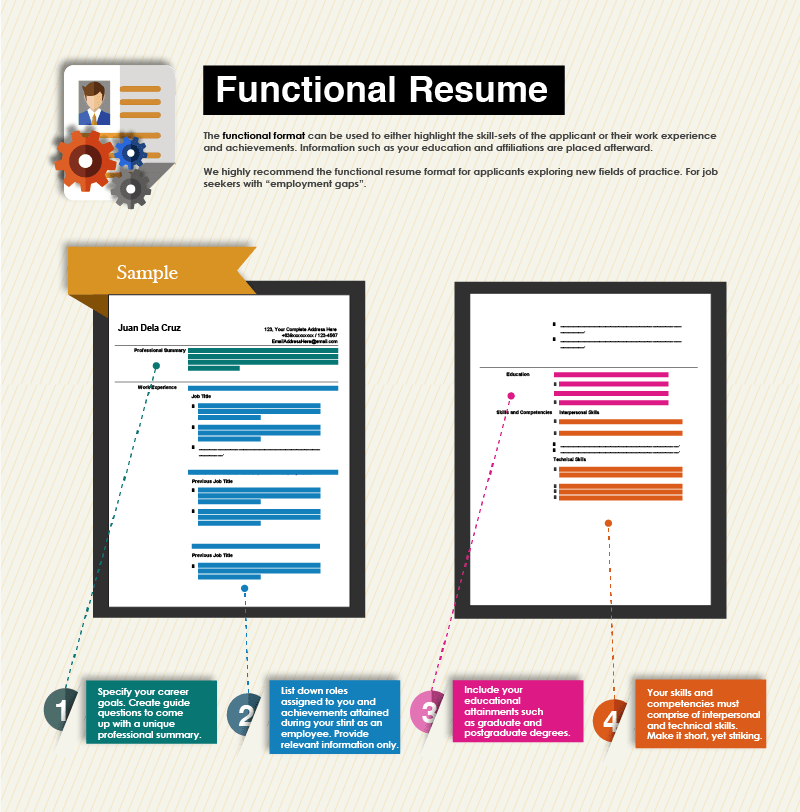


The functional format may sound new to most readers who recycle the same chronological resume format from their previous job hunts. This format may either highlight the skill-sets of the applicant or their work experience and achievements. Information such as your education and affiliations are placed afterward.
We highly recommend the functional resume format for applicants exploring new fields of practice. For job seekers with “employment gaps,” Monster finds the functional format appropriate to use in highlighting your specializations instead.
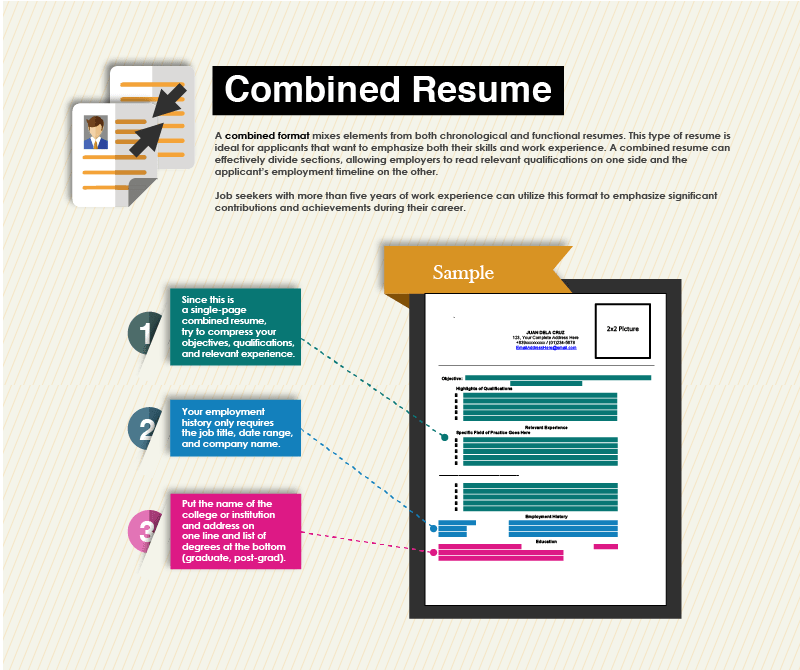


A combined format integrates parts from both chronological and functional resumes. This type of resume puts emphasis on both skills and work experience. The applicant can divide and place their relevant qualifications on one side and their employment timeline on the other half, allowing employers to quickly scan through specific sections of their resumes.
Our sample above is a single-page combined resume. The applicant starts with the relevant experience first, the employment history on the second, and lastly, their academic history. Job seekers with more than five years of work experience can utilize this format to emphasize significant contributions and achievements during their career.
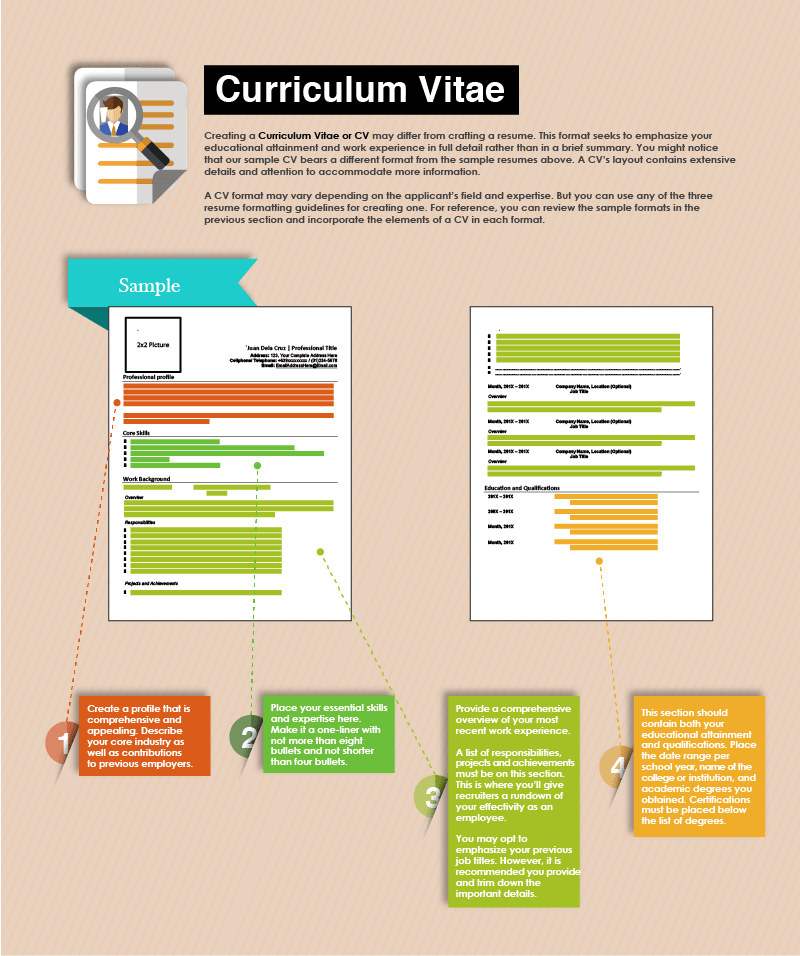


Creating a CV may differ from crafting a resume. As previously mentioned, this document emphasizes your educational attainment and work experience in full detail rather than in a brief summary. You might notice that our sample CV bears a different format from the sample resumes above. A CV’s layout contains extensive details and attention to accommodate more information.
The Balance Careers states that a CV format may vary depending on the applicant’s field and expertise. But you can use any of the three resume formatting guidelines for creating a CV. For reference, you can review the sample formats in the previous section and incorporate the elements of a CV in each format.
3. Fill Up the Resume or CV
After selecting your preferred format, you can now create the initial draft. The arrangement between work history and skills may vary based on your format. Emphasize either your technical and interpersonal skills, or your work experience.
Start first by writing your resume header. The header must include your complete name, home address, email address, and contact numbers. Provide your main profile with an overview of your experience and abilities. Then arrange the details based on your chosen format.
4. Format and Proofread
After providing the necessary information and using the resume format of your choice, now’s the time to re-check your entire piece. Are the font sizes consistent? How about the spaces and indentations on the document? Can you still fit more details on one page? Make it a practice to scan your resume until everything looks uniform.
But, don’t forget to check every word you type on the resume and proofread afterwards. Employers usually read the core skills and work experience of the applicant before the rest of the sections in their resumes or CVs. Typos and misspelled words on the work experience and skill-set sections may cause recruiters to think that you rushed the creation of the job application.
5. Recheck then Submit your Application
After writing your resume or CV from scratch, scanning the entire document for any errors on formatting, and proofreading the content to make sure that recruiters can immediately identify your strengths and contributions, the most crucial part: applying for a job.
If you’re confident that the resume is ready for submission to recruiters, look for prospect companies and send copies of your application. Don’t forget to provide a nice cover letter to properly introduce yourself and entice employers of what you can contribute to the workforce.
Finally, your resume will represent who you are and how you can contribute to different organizations, so don’t lose focus and pay attention during interviews. You may run through different recruiters from various fields, but at the end of the job hunt, a greater opportunity will be waiting for you. Good luck, job seekers!


Great post.
Nice post!